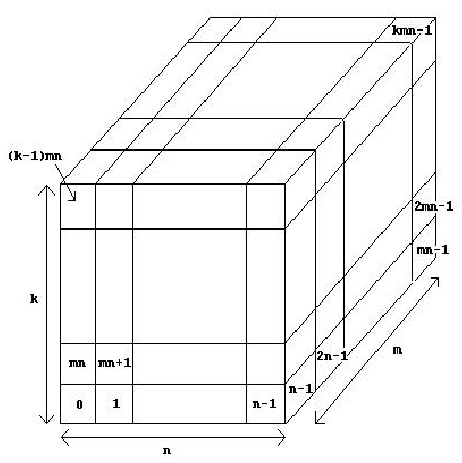[ACM_搜索] POJ 1096 Space Station Shielding (搜索 + 洪泛算法Flood_Fill)
Description
Input

Output
The number of faces needing shielding is s.
Sample Input
2 2 1 3
0 1 3
3 3 3 26
0 1 2 3 4 5 6 7 8 9
10 11 12 14 15 16 17 18 19 20
21 22 23 24 25 26
0 0 0 0
Sample Output
The number of faces needing shielding is 14.
The number of faces needing shielding is 54.
Source
题目大意:给你一个正长方体,长宽高分别为n、m、k,这个长方体由n*m*k个1*1*1的小立方体组成,把这些小立方体编号为0-(n*m*k-1),再给l个编号,表示这些小立方体是存在的,否则就是不存在的。求最总整个图形的外表面积。
解题思路:首先想到,以其中一个存在的小立方体开始,往上下左右前后六个方向搜索,如果这个方向上有小方块,就转移到这个小方块上继续搜索,如果没有,则表面积+1,但是这个方法求出来的包含内表面积!!!于是采用反向思维,在这个立方体周围包一层不存在立方体(这里的不存在就是标记该位置单位立方体tab[i][j][k]=0,存在为1),然后再按上面的方法改成搜索“不存在的小立方体”,只搜索最外圈,那么我们得到的结果就是最外圈那些“不存在的小立方体”所构成的部分的内外表面积之和,它的内表面积就是我们要求的“存在的小立方体组成的物体”的外表面积了。而它的外表面积就是(n*m+m*k+n*k)*2,其实可以不用算,在搜索的时候如果是边界不用+1就行了。注意要用BFS,刚开始用DFS栈溢出了。
知识扩展:这题是标准的洪泛算法的题目,记得勘测油田的那道简单搜索题吗?还有某些画图软件上的把图像上相连的某种颜色换成其他的,你点一块其他全部变化啦。这些都是洪泛算法的应用。本题意思是有一个由单位立方体组成的长方体,有些单位立方体内有宇航员,而外太空的毒气可以渗入没有贴防护膜的房间,所以要在某些必要的位置贴防护膜来防止毒气进入太空站空间。
相关链接:维基百科——洪泛算法:http://zh.wikipedia.org/zh-cn/Flood_fill
图像处理之泛洪填充算法(Flood Fill Algorithm) :http://blog.csdn.net/jia20003/article/details/8908464
洪泛算法讲解:http://www.nocow.cn/index.php/Flood_Fill
#include<iostream>
#include<string.h>
#include<queue>
using namespace std;
int n,m,k,l;
bool tab[][][],visit[][][];
int face_num;
class W3{
public:
int x,y,z;
W3& set(int xx,int yy,int zz){
x=xx;y=yy;z=zz;
return *this;
}
};
void bfs(){
face_num=;
queue<W3> Q;
W3 temp;
Q.push(temp.set(,,));
while(!Q.empty()){
W3 Top=Q.front();Q.pop();
if(visit[Top.x][Top.y][Top.z])continue;
visit[Top.x][Top.y][Top.z]=;
if(Top.x->=){
if(tab[Top.x-][Top.y][Top.z]==){
if(!visit[Top.x-][Top.y][Top.z])Q.push(temp.set(Top.x-,Top.y,Top.z));
}
else face_num++;
}//左走一格
if(Top.x<=n){
if(tab[Top.x+][Top.y][Top.z]==){
if(!visit[Top.x+][Top.y][Top.z])Q.push(temp.set(Top.x+,Top.y,Top.z));
}
else face_num++;
}//右走一格
if(Top.y->=){
if(tab[Top.x][Top.y-][Top.z]==){
if(!visit[Top.x][Top.y-][Top.z])Q.push(temp.set(Top.x,Top.y-,Top.z));
}
else face_num++;
}//后走一格
if(Top.y<=m){
if(tab[Top.x][Top.y+][Top.z]==){
if(!visit[Top.x][Top.y+][Top.z])Q.push(temp.set(Top.x,Top.y+,Top.z));
}
else face_num++;
}//前走一格
if(Top.z->=){
if(tab[Top.x][Top.y][Top.z-]==){
if(!visit[Top.x][Top.y][Top.z-])Q.push(temp.set(Top.x,Top.y,Top.z-));
}
else face_num++;
}//下走一格
if(Top.z<=k){
if(tab[Top.x][Top.y][Top.z+]==){
if(!visit[Top.x][Top.y][Top.z+])Q.push(temp.set(Top.x,Top.y,Top.z+));
}
else face_num++;
}//上走一格
}
}
int main(){
while(cin>>n>>m>>k>>l){
if(!n && !m && !k && !l)break;
memset(tab,,sizeof(tab));
memset(visit,,sizeof(visit));
int temp1;
for(int i=;i<l;i++){
cin>>temp1;
tab[temp1%(m*n)%n+][temp1%(m*n)/n+][temp1/(n*m)+]=;
}//输入数据并转换为tab[][][]的3维矩阵(这里从1,1,1开始,最外层相当于无人方块)
bfs();
cout<<"The number of faces needing shielding is "<<face_num<<".\n";
}return ;
}
[ACM_搜索] POJ 1096 Space Station Shielding (搜索 + 洪泛算法Flood_Fill)的更多相关文章
- poj 2031 Building a Space Station【最小生成树prime】【模板题】
Building a Space Station Time Limit: 1000MS Memory Limit: 30000K Total Submissions: 5699 Accepte ...
- (最小生成树) Building a Space Station -- POJ -- 2031
链接: http://poj.org/problem?id=2031 Time Limit: 1000MS Memory Limit: 30000K Total Submissions: 6011 ...
- POJ 3126 Prime Path 广度优先搜索 难度:0
http://poj.org/problem?id=3126 搜索的时候注意 1:首位不能有0 2:可以暂时有没有出现在目标数中的数字 #include <cstdio> #include ...
- POJ 2031 Building a Space Station【经典最小生成树】
链接: http://poj.org/problem?id=2031 http://acm.hust.edu.cn/vjudge/contest/view.action?cid=22013#probl ...
- Building a Space Station POJ - 2031
Building a Space Station POJ - 2031 You are a member of the space station engineering team, and are ...
- Building a Space Station POJ 2031 【最小生成树 prim】
http://poj.org/problem?id=2031 Description You are a member of the space station engineering team, a ...
- POJ 2031 Building a Space Station
3维空间中的最小生成树....好久没碰关于图的东西了..... Building a Space Station Time Limit: 1000MS Memory Li ...
- POJ 2031 Building a Space Station (最小生成树)
Building a Space Station Time Limit: 1000MS Memory Limit: 30000K Total Submissions: 5173 Accepte ...
- POJ 2031 Building a Space Station (最小生成树)
Building a Space Station 题目链接: http://acm.hust.edu.cn/vjudge/contest/124434#problem/C Description Yo ...
随机推荐
- 7.29 H5学习笔记
常用实体字符小于号 < 大于号 > 和号 & 引号 " 撇号 ' 分 ¢ 镑 £ 日元 ¥ 欧元 € 小节 § 版权 © 注册 ...
- UVM的factory机制
在UVM中使用工厂模式基本上分为三个步骤: 1. 注册 当定义一个类的时候,它的类型必须要注册,UVM已经提供了专用的宏. `uvm_component_utils(class_type_name) ...
- js中的单体对象
- 转 Eric Raymond对于几大开发语言的评价
原文见:http://blog.jobbole.com/79421/ [译注]:Eric Raymond是开源运动的领袖人物,对于UNIX开发有很深的造诣,主持开发了fetchmail.他的<大 ...
- 在Linux中的文本模式下手动安装 Parallels Tools
1.启动虚拟机. 2.当看到提示 X Server 无法启动的消息时,使用 Ctrl+Option+F1(Ctrl+Alt+F1)切换到另一个虚拟控制台并输入登录信息. 3 从“虚拟机”菜单中选择“安 ...
- Python全栈--6.1-match-search-findall-group(s)的区别以及计算器实例
match.search.findall.group(s) 区别 import re # match findall经常用 # re.match() #从开头匹配,没有匹配到对象就返回NONE # r ...
- java多线程学习-ThreadLocal
为了凑字,把oracle文档里介绍ThreadLocal抄过来 public class ThreadLocal<T> extends Object This class provides ...
- c++ 递归斐波那契算法及时间复杂度
#include<iostream> int fib(int n){ ) return n; else ) + fib(n-); } int main(){ ;i<;i++){ st ...
- Entity Framework 6.0 源码解读笔记(一)
internal static TResult ExecuteSingle<TResult>(IEnumerable<TResult> query, Expression qu ...
- Linux常用命名
一:命名基本格式 [root@localhost ~]# root: 用户名 localhost: 主机名 (windows在局域网,不能有相同的主机名) ~:当前所在位置 (家目录) root ...
